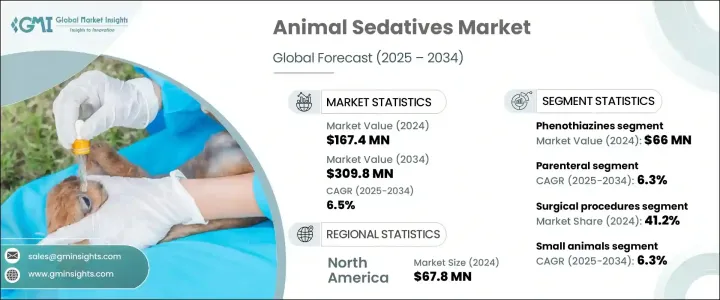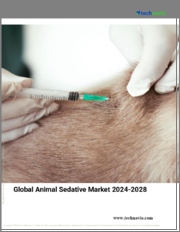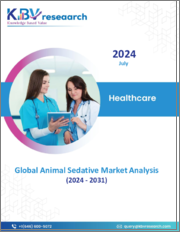
|
시장보고서
상품코드
1716460
동물용 진정제 시장 기회, 성장 촉진 요인, 산업 동향 분석, 예측(2025-2034년)Animal Sedatives Market Opportunity, Growth Drivers, Industry Trend Analysis, and Forecast 2025 - 2034 |
||||||
동물용 진정제 세계 시장은 2024년에 1억 6,740만 달러로 평가되었으며, 고급 수의학과 혁신적인 동물 건강 관리 솔루션에 대한 수요가 급증함에 따라 2025년부터 2034년까지 연평균 복합 성장률(CAGR) 6.5%로 성장할 것으로 예측됩니다.
반려동물의 사육이 세계적으로, 특히 도시 지역에서 계속 증가하고 있기 때문에 주인은 반려동물의 건강에 대해 점점 적극적으로되고, 안전하고 효과적인 진정제 등 고품질의 치료법을 요구합니다. 동물의 건강, 스트레스 관리, 행동 제어에 대한 의식의 고조는 치료, 수송, 정리시에 동물을 진정시키는 진정제에 대한 수요에 박차를 가하고 있습니다.

게다가, 식육이나 동물성 식품 수요 증가에 대응하기 위해서 가축 생산이 현저하게 증가하고 있기 때문에 진찰, 수술, 수송중에 가축을 취급하기 위한 효과적인 진정 방법에 대한 요구가 커지고 있습니다. 수의 전문가도 스트레스가 없는 핸들링과 정확한 진단의 중요성을 강조하고 있어, 그 때문에 수술, 관절염과 암을 포함한 반려동물의 만성 질환의 유병률 증가는 빈번한 수의사의 진찰과 치료를 필요로 하며 동물용 진정제의 사용을 더욱 강화하고 있습니다. 발전과 함께 수의학적 인프라와 연구에 대한 투자가 증가하고 있는 것은 세계 시장의 성장에 기여하고 있으며, 동물용 진정제는 현대 수의학적 진료에 필수적인 요소가 되고 있습니다.
| 시장 범위 | |
|---|---|
| 시작 연도 | 2024년 |
| 예측 연도 | 2025-2034년 |
| 시작 금액 | 1억 6,740만 달러 |
| 예측 금액 | 3억980만 달러 |
| CAGR | 6.5% |
시장은 약물 분류별로 페노티아진, α2 아드레날린 수용체 작용제, 벤조디아제핀, 부티로페논, 기타 카테고리로 구분됩니다. 이 가운데 페노티아진(Phenothiazines) 부문은 2024년에 6,600만 달러를 생산하는 주요 부문으로 떠오르며, 광범위한 용도로 계속 우위를 차지하고 있습니다. 환경에서 동물의 긴장 완화를 위해 페노티아진계 약물을 널리 선호하고 사용하고 있습니다. 경구용과 주사형으로 제공되는 페노티아진은 유연성과 편의성을 제공하여 수의사와 반려동물 소유자 모두에게 최고의 선택입니다.
투여 경로에 따라 시장은 경구용과 비경구용으로 나뉘어 있습니다. 2025-2034년 연평균 6.3%의 성장률로 성장할 것으로 예상되는 비경구 투여 부문은 긴급 치료, 수술, 진단 개입 시 즉각적인 진정제로 계속 선호되고 있습니다.
북미의 동물용 진정제 시장은 2024년에 6,780만 달러로 평가되었지만, 이는 주로 이 지역의 고급 수의학적 인프라와 동물의 건강과 복지에 대한 관심이 높아짐으로써 수의학이 고도화되고 진단과 외과적 개입이 증가함에 따라 따라서 안전하고 효과적인 진정제 수요는 증가의 길을 따라가고 있습니다. 반려동물의 주인도 가축의 관리자 모두 동물의 쾌적성과 안전성을 우선하고 있으며, 동물 병원에서 신뢰성이 높은 진정 옵션의 필요성을 뒷받침하고 있습니다.
목차
제1장 조사 방법과 조사 범위
제2장 주요 요약
제3장 업계 인사이트
- 생태계 분석
- 업계에 미치는 영향요인
- 성장 촉진요인
- 반려동물 사육 증가
- 동물 수술 수술 증가
- 동물 및 인수 공통 감염증 증가
- 동물 헬스케어 지출 증가와 동물용 제품 개발 활동에 대한 투자 증가
- 업계의 잠재적 위험 및 과제
- 동물용 진정제에 수반하는 부작용
- 동물용 진정제의 승인에 관한 정부의 엄격한 규제
- 숙련된 인재의 부족
- 성장 촉진요인
- 성장 가능성 분석
- 규제 상황
- Porter's Five Forces 분석
- PESTEL 분석
제4장 경쟁 구도
- 소개
- 기업 매트릭스 분석
- 주요 시장 기업의 경쟁 분석
- 경쟁 포지셔닝 매트릭스
- 전략 대시보드
제5장 시장 추정 및 예측 : 약제 클래스별, 2021년-2034년
- 주요 동향
- 페노티아진
- α2 아드레날린 수용체 작용제
- 벤조디아제핀
- 부티로페논
- 기타 약제 클래스별
제6장 시장 추정 및 예측 : 투여 경로별, 2021년-2034년
- 주요 동향
- 비경구제
- 경구제
제7장 시장 추정 및 예측 : 용도별, 2021년-2034년
- 주요 동향
- 수술 수술
- 진단 절차
- 임상 연구
- 기타 용도
제8장 시장 추정 및 예측 : 동물 유형별, 2021년-2034년
- 주요 동향
- 작은 동물
- 개
- 고양이
- 기타 작은 동물
- 대형 동물
- 소
- 말
- 기타 대형 동물
제9장 시장 추정 및 예측 : 지역별, 2021년-2034년
- 주요 동향
- 북미
- 미국
- 캐나다
- 유럽
- 독일
- 영국
- 프랑스
- 이탈리아
- 스페인
- 네덜란드
- 아시아태평양
- 중국
- 일본
- 인도
- 호주
- 한국
- 라틴아메리카
- 브라질
- 멕시코
- 아르헨티나
- 중동 및 아프리카
- 남아프리카
- 사우디아라비아
- 아랍에미리트(UAE)
제10장 기업 프로파일
- Bayer
- Boehringer Ingelheim Animal Health
- Ceva Animal Health
- Chanelle Pharma
- Dechra Pharmaceuticals
- Elanco Animal Health Incorporated
- Jurox Pty Limited
- Orion Corporation
- Virbac
- Zoetis
The Global Animal Sedatives Market was valued at USD 167.4 million in 2024 and is projected to grow at a CAGR of 6.5% between 2025 and 2034, driven by the surging demand for advanced veterinary care and innovative animal healthcare solutions. As pet adoption continues to rise worldwide, particularly in urban settings, owners are becoming increasingly proactive about their pets' health, seeking high-quality treatment options, including safe and effective sedatives. Growing awareness about animal wellness, stress management, and behavioral control is fueling the demand for sedatives that aid in calming animals during procedures, transportation, and grooming.

Additionally, with a notable increase in livestock production to meet the escalating demand for meat and animal-based food products, the requirement for effective sedation methods to handle farm animals during medical examinations, surgeries, and transportation has gained significant traction. Veterinary professionals are also emphasizing the importance of stress-free handling and precise diagnosis, which has led to a higher number of animals undergoing surgeries, dental cleanings, and diagnostic imaging, all of which often require sedation. The rising prevalence of chronic diseases among companion animals, including arthritis and cancer, necessitates frequent veterinary visits and treatments, further bolstering the use of animal sedatives. Increasing investments in veterinary infrastructure and research, along with technological advancements in sedative formulations, are contributing to market growth globally, making animal sedation an essential component of modern veterinary practices.
| Market Scope | |
|---|---|
| Start Year | 2024 |
| Forecast Year | 2025-2034 |
| Start Value | $167.4 Million |
| Forecast Value | $309.8 Million |
| CAGR | 6.5% |
The market is segmented by drug class into phenothiazines, alpha-2 adrenergic receptor agonists, benzodiazepines, butyrophenones, and other categories. Among these, phenothiazines emerged as the leading segment, generating USD 66 million in 2024, and continue to dominate due to their wide range of applications. Veterinarians widely prefer phenothiazines for pre-anesthetic sedation, behavioral control, and easing animals in stressful environments such as transport or grooming sessions. Available in both oral and injectable forms, phenothiazines offer flexibility and convenience, making them a top choice among veterinary professionals and pet owners for both companion animals and livestock. Their proven efficacy in calming animals without significant side effects makes them one of the most trusted sedative classes in the market.
Based on route of administration, the market is bifurcated into oral and parenteral segments. The parenteral segment, anticipated to grow at a CAGR of 6.3% during 2025-2034, remains the preferred choice for fast-acting sedation during emergency procedures, surgeries, and diagnostic interventions. Parenteral sedatives are critical in ensuring immediate calming effects, making them indispensable for veterinarians performing complex procedures that require animals to remain still and stress-free.
North America Animal Sedatives Market was valued at USD 67.8 million in 2024, largely due to the region's advanced veterinary infrastructure and increasing focus on animal health and welfare. As veterinary care becomes more sophisticated, with a growing number of diagnostic and surgical interventions, the demand for safe and effective sedatives continues to rise. Pet owners and livestock managers alike are prioritizing animal comfort and safety, driving the need for reliable sedation options in veterinary practices.
Table of Contents
Chapter 1 Methodology and Scope
- 1.1 Market scope and definition
- 1.2 Research design
- 1.2.1 Research approach
- 1.2.2 Data collection methods
- 1.3 Base estimates and calculations
- 1.3.1 Base year calculation
- 1.3.2 Key trends for market estimation
- 1.4 Forecast model
- 1.5 Primary research and validation
- 1.5.1 Primary sources
- 1.5.2 Data mining sources
Chapter 2 Executive Summary
- 2.1 Industry 3600 synopsis
Chapter 3 Industry Insights
- 3.1 Industry ecosystem analysis
- 3.2 Industry impact forces
- 3.2.1 Growth drivers
- 3.2.1.1 Increasing pet ownership
- 3.2.1.2 Rising surgical procedures in animals
- 3.2.1.3 Increasing incidences of animal and zoonotic diseases
- 3.2.1.4 Increasing animal healthcare expenditure & growing investment in veterinary product development activities
- 3.2.2 Industry pitfalls and challenges
- 3.2.2.1 Side effects associated with animal sedatives
- 3.2.2.2 Stringent government regulation for approval of animal sedatives
- 3.2.2.3 Lack of skilled personnels
- 3.2.1 Growth drivers
- 3.3 Growth potential analysis
- 3.4 Regulatory landscape
- 3.5 Porter's analysis
- 3.6 PESTEL analysis
Chapter 4 Competitive Landscape, 2024
- 4.1 Introduction
- 4.2 Company matrix analysis
- 4.3 Competitive analysis of major market players
- 4.4 Competitive positioning matrix
- 4.5 Strategy dashboard
Chapter 5 Market Estimates and Forecast, By Drug Class, 2021 - 2034 ($ Mn)
- 5.1 Key trends
- 5.2 Phenothiazines
- 5.3 Alpha-2 adrenergic receptor agonist
- 5.4 Benzodiazepines
- 5.5 Butyrophenones
- 5.6 Other drug classes
Chapter 6 Market Estimates and Forecast, By Route of Administration, 2021 - 2034 ($ Mn)
- 6.1 Key trends
- 6.2 Parenteral
- 6.3 Oral
Chapter 7 Market Estimates and Forecast, By Application, 2021 - 2034 ($ Mn)
- 7.1 Key trends
- 7.2 Surgical procedures
- 7.3 Diagnostic procedures
- 7.4 Clinical research studies
- 7.5 Other applications
Chapter 8 Market Estimates and Forecast, By Animal Type, 2021 - 2034 ($ Mn)
- 8.1 Key trends
- 8.2 Small animals
- 8.2.1 Dogs
- 8.2.2 Cats
- 8.2.3 Other small animals
- 8.3 Large animals
- 8.3.1 Cattle
- 8.3.2 Horses
- 8.3.3 Other large animals
Chapter 9 Market Estimates and Forecast, By Region, 2021 - 2034 ($ Mn)
- 9.1 Key trends
- 9.2 North America
- 9.2.1 U.S.
- 9.2.2 Canada
- 9.3 Europe
- 9.3.1 Germany
- 9.3.2 UK
- 9.3.3 France
- 9.3.4 Italy
- 9.3.5 Spain
- 9.3.6 Netherlands
- 9.4 Asia Pacific
- 9.4.1 China
- 9.4.2 Japan
- 9.4.3 India
- 9.4.4 Australia
- 9.4.5 South Korea
- 9.5 Latin America
- 9.5.1 Brazil
- 9.5.2 Mexico
- 9.5.3 Argentina
- 9.6 Middle East and Africa
- 9.6.1 South Africa
- 9.6.2 Saudi Arabia
- 9.6.3 UAE
Chapter 10 Company Profiles
- 10.1 Bayer
- 10.2 Boehringer Ingelheim Animal Health
- 10.3 Ceva Animal Health
- 10.4 Chanelle Pharma
- 10.5 Dechra Pharmaceuticals
- 10.6 Elanco Animal Health Incorporated
- 10.7 Jurox Pty Limited
- 10.8 Orion Corporation
- 10.9 Virbac
- 10.10 Zoetis

















